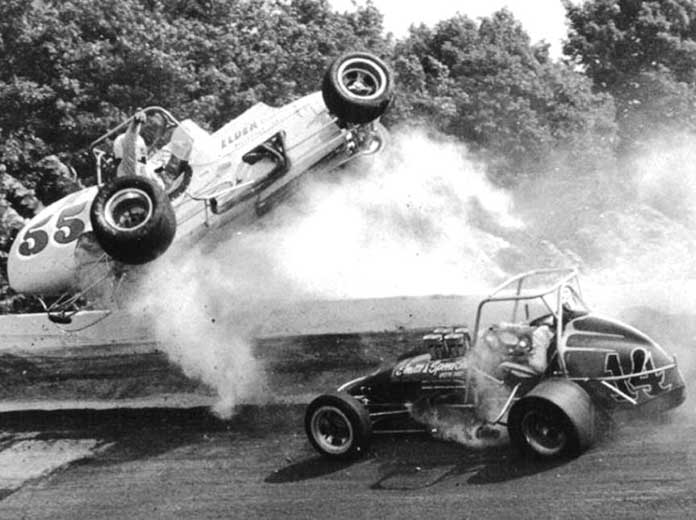Iconic two-time Indianapolis 500 winner Bill Vukovich called the races run on Indiana’s Winchester and Salem Speedways, “The Idiot Circuit.”
And in his typical no holds barred style, added that those who ran them were, “…nuts.”
Vuky spoke from firsthand knowledge. As much as he detested the high-banked tracks, he ran at Salem at the beginning of his AAA career. It was a time when success there could advance a driver to Indianapolis. He won his heat.
WW II Marine Mike Nazaruk, unyielding on the battlefield, more so in a sprint car, once motioned friend, Kenny Woods, to his car, as he waited to push off at Winchester.
“Mike pointed down into the cockpit,” recalled Woods, “and his knees were shaking. ‘Iron Mike’ had the shakes. I couldn’t believe it. Mike told me, ‘Kenny, any SOB who says he ain’t scared to drive these high banks is crazy. He’s ready to die.’”
Pancho Carter, considered by many the all-time master of the half-mile high banks, responded when asked how he was so fast on them, “Because I was damn stupid.”
Nuts. Ready to die. Damn stupid. Winchester and Salem evoke those type of emotions in even the boldest men.
Located in southern Indiana, Salem Speedway is banked at 33 degrees. In the northern half of the state, Winchester’s turns rise to a daunting 37 degrees. Both tracks have featured high-speed, dangerous racing for decades. The specter of danger is a large part of the attraction.
Not that fans desire to witness tragic accidents, but when their favorite driver straps in at these tracks designed for all-out speed, it’s understood the results could be catastrophic. That they do it anyway, elevates drivers to mystical status, operating in a rarified realm where only the toughest, bravest and intense succeed — and survive.

That danger compels drivers as well.
Tony Stewart, who tumbled over Salem’s bank in a 1992 crash with Steve Butler, remarked, “Racing has always been dangerous. The reason people go watch races is because there’s an element of danger involved. It’s dangerous, but we all still do it.”
“Without danger, there really wouldn’t be any point to it,” remarked Sir Sterling Moss. “It would be like climbing a mountain with a net ready to catch you. What’s the point?”
The danger adds a challenging element for the drivers and attracts fans.
Winchester had been around since 1916 when Salem opened in 1947. That created competition between the tracks that grew as heated as the on-track competition. They paid $500 a pop for new records. And, these weren’t merely track records, but, headline-grabbing, “World Records for A Half-Mile Track.”
Delivering those spectacular speeds was an influx of young drivers who ramped up fan intensity with red-hot rivalries. Fights in the stands, heavy betting and near riots became the norm as fans fanatically supported their favorites.
Troy Ruttman, 18, broke into the high-bank scene in 1949 and immediately put fans and veteran drivers on notice. He won the first time he set eyes on Salem Speedway.
Ruttman won so often that tracks offered a $500 bounty to any driver who could beat him. It went unclaimed. The wheel-banging, tire-smoking action between Ruttman and Jackie Holmes grew so violent the AAA sat them down for a get-your-heads-on-straight meeting. It slowed them little.
After the Ruttman/Holmes rivalry cooled, another between Ruttman and Duane Carter flared. The pair exchanged track records, victories and championships for three fervent years.
In his mid-30s, Carter told questioners that he competed against these youngsters and fought hard for one reason, “I race for a living.”
It was Carter who figured prominently in the most infamous day of that era. July 29, 1951 became known as “Black Sunday.” Walt Brown died in a crash at Pennsylvania’s Williams Grove Speedway and two men perished in successive crashes during qualifying at Winchester.
Driving Troy Ruttman’s usual sprint car ride, the Agajanian No. 98jr, Cecil Green roared out to qualify, spun, and plummeted 75 feet down Winchester’s first-turn embankment. He died in the impact. Bill Mackey was up next. His crash mirrored Green’s with an identical result.
Then it was Carter’s turn.
Click below to keep reading.
